seats MERCEDES-BENZ SLC 2019 Owners Manual
[x] Cancel search | Manufacturer: MERCEDES-BENZ, Model Year: 2019, Model line: SLC, Model: MERCEDES-BENZ SLC 2019Pages: 306, PDF Size: 15 MB
Page 4 of 306
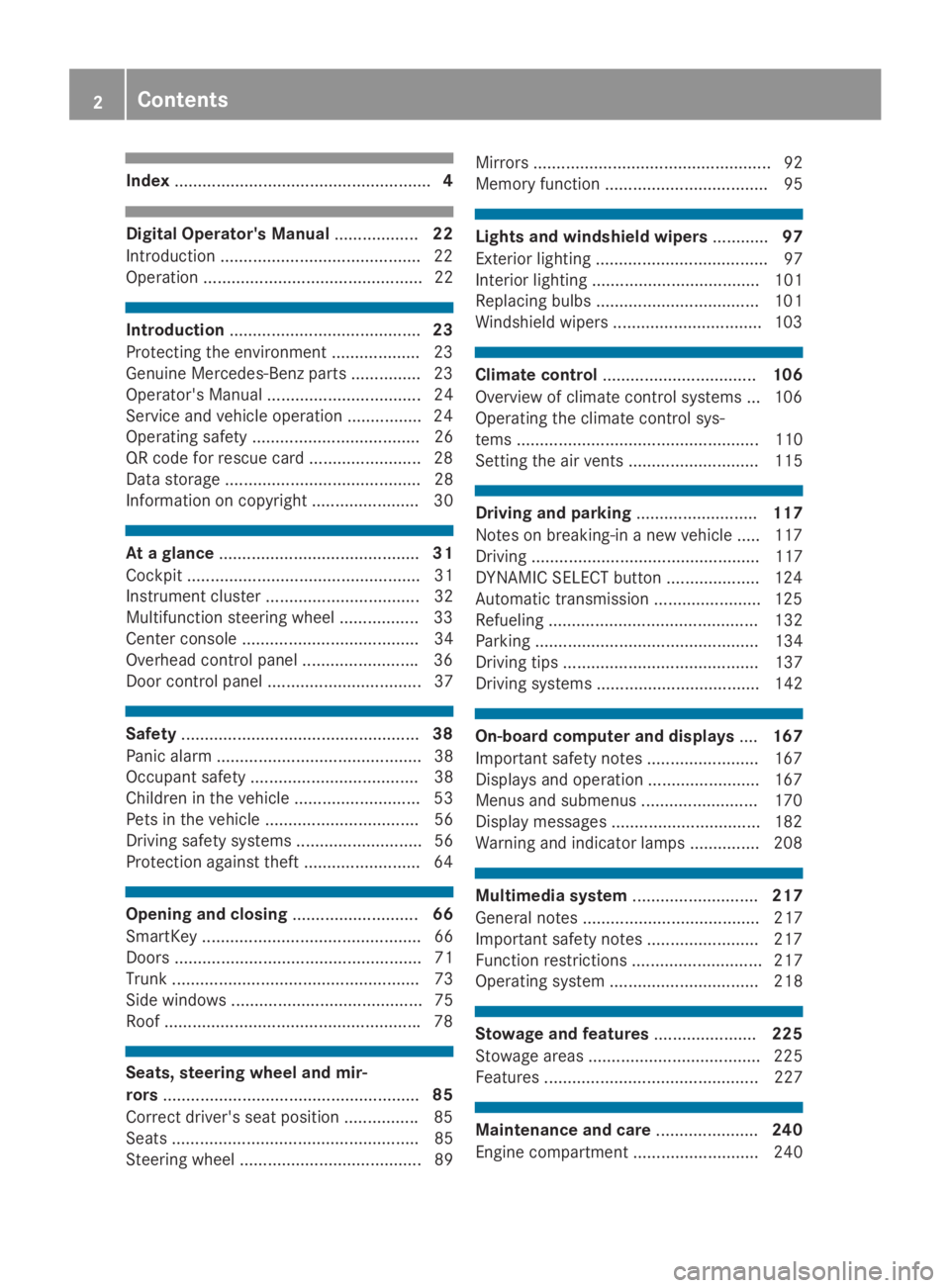
Index.......................................................4
Digital Operator's Manual..................22
Introduction ...........................................22
Operation ............................................... 22
Introduction.........................................23
Protecting the environment ...................23
Genuine Mercedes-Benz parts ...............23
Operator's Manual ................................. 24
Service and vehicle operation ................24
Operating safety .................................... 26
QR code for rescue card ........................ 28
Data storage .......................................... 28
Information on copyright ....................... 30
At a glance...........................................31
Cockpit .................................................. 31
Instrument cluster ................................. 32
Multifunction steering wheel ................. 33
Center console ...................................... 34
Overhead control panel .........................36
Door control panel ................................. 37
Safety...................................................38
Panic alarm ............................................ 38
Occupant safety .................................... 38
Children in the vehicle ........................... 53
Pets in the vehicle ................................. 56
Driving safety systems ........................... 56
Protection against theft .........................64
Opening and closing...........................66
SmartKey ............................................... 66
Doors ..................................................... 71
Trunk ..................................................... 73
Side windows ......................................... 75
Roof .......................................................78
Seats, steering wheel and mir-
rors.......................................................85
Correct driver's seat position ................85
Seats ..................................................... 85
Steering wheel ....................................... 89
Mirrors ................................................... 92
Memory function ................................... 95
Lights and windshield wipers............97
Exterior lighting ..................................... 97
Interior lighting .................................... 101
Replacing bulbs ................................... 101
Windshield wipers ................................ 103
Climate control.................................106
Overview of climate control systems ... 106
Operating the climate control sys-
tems .................................................... 110
Setting the air vents ............................ 115
Driving and parking..........................117
Notes on breaking-in a new vehicle ..... 117
Driving ................................................. 117
DYNAMIC SELECT button .................... 124
Automatic transmission ....................... 125
Refueling ............................................. 132
Parking ................................................ 134
Driving tips .......................................... 137
Driving systems ................................... 142
On-board computer and displays....167
Important safety notes ........................ 167
Displays and operation ........................ 167
Menus and submenus ......................... 170
Display messages ................................ 182
Warning and indicator lamps ............... 208
Multimedia system...........................217
General notes ...................................... 217
Important safety notes ........................ 217
Function restrictions ............................ 217
Operating system ................................ 218
Stowage and features......................225
Stowage areas ..................................... 225
Features .............................................. 227
Maintenance and care......................240
Engine compartment ........................... 240
2Contents
Page 18 of 306
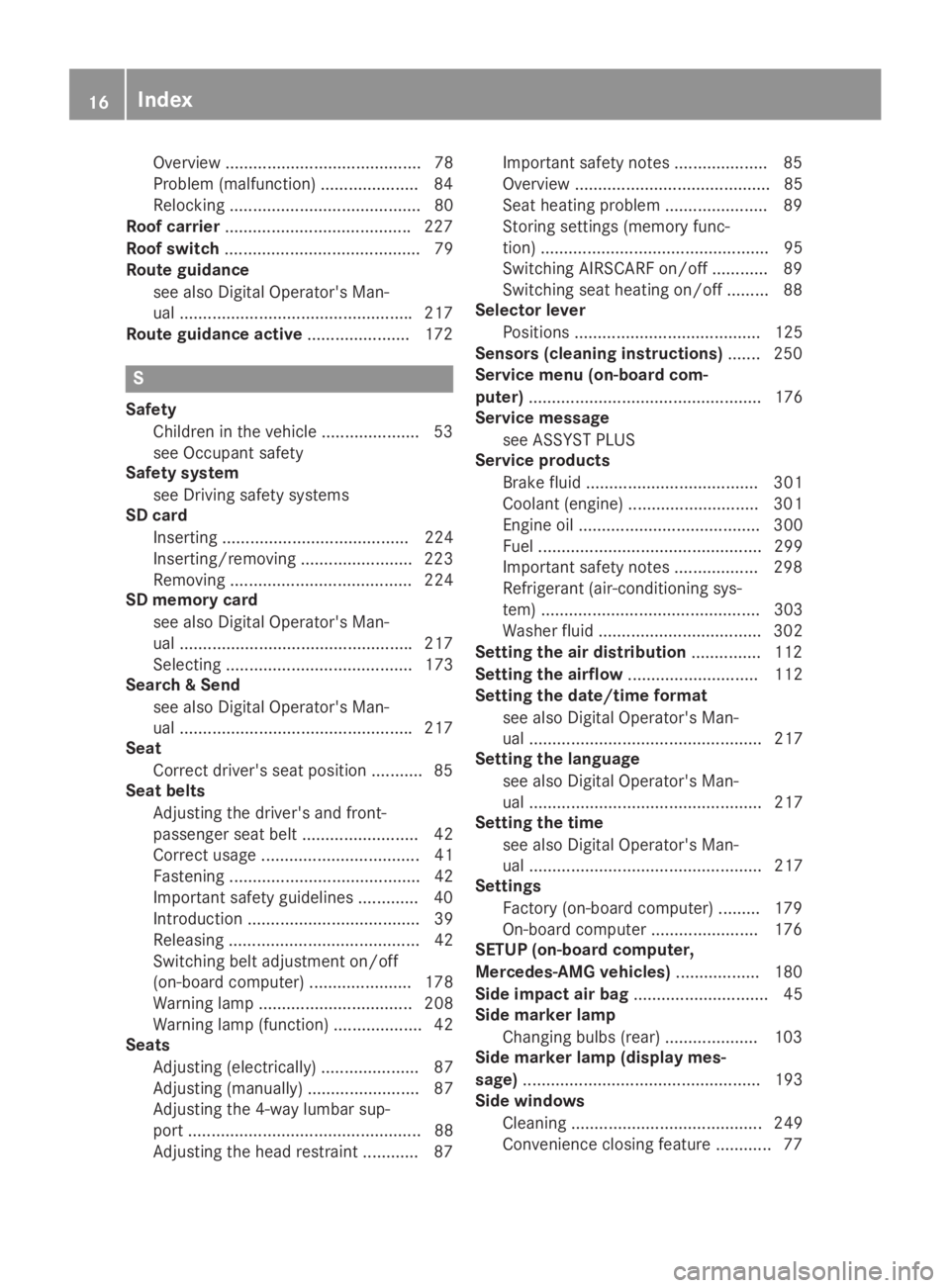
Overview .......................................... 78
Problem (malfunction) ..................... 84
Relocking ......................................... 80
Roof carrier........................................227
Roof switch.......................................... 79
Route guidance
see also Digital Operator's Man-
ual ..................................................217
Route guidance active......................172
S
Safety
Children in the vehicle ..................... 53
see Occupant safety
Safety system
see Driving safety systems
SD card
Inserting ........................................ 224
Inserting/removing ........................ 223
Removing ....................................... 224
SD memory card
see also Digital Operator's Man-
ual ..................................................217
Selecting ........................................ 173
Search & Send
see also Digital Operator's Man-
ual ..................................................217
Seat
Correct driver's seat position ........... 85
Seat belts
Adjusting the driver's and front-
passenger seat belt......................... 42
Correct usage .................................. 41
Fastening ......................................... 42
Important safety guidelines ............. 40
Introduction ..................................... 39
Releasing ......................................... 42
Switching belt adjustment on/off
(on-board computer) ...................... 178
Warning lamp ................................. 208
Warning lamp (function) ................... 42
Seats
Adjusting (electrically) ..................... 87
Adjusting (manually) ........................ 87
Adjusting the 4-way lumbar sup-
port .................................................. 88
Adjusting the head restraint ............ 87
Important safety notes .................... 85
Overview .......................................... 85
Seat heating problem ...................... 89
Storing settings (memory func-
tion) ................................................. 95
Switching AIRSCARF on/off............ 89
Switching seat heating on/off......... 88
Selector lever
Positions ........................................ 125
Sensors (cleaning instructions)....... 250
Service menu (on-board com-
puter).................................................. 176
Service message
see ASSYST PLUS
Service products
Brake fluid ..................................... 301
Coolant (engine) ............................ 301
Engine oil ....................................... 300
Fuel ................................................ 299
Important safety notes .................. 298
Refrigerant (air-conditioning sys-
tem) ............................................... 303
Washer fluid ................................... 302
Setting the air distribution............... 112
Setting the airflow............................ 112
Setting the date/time format
see also Digital Operator's Man-
ual .................................................. 217
Setting the language
see also Digital Operator's Man-
ual .................................................. 217
Setting the time
see also Digital Operator's Man-
ual .................................................. 217
Settings
Factory (on-board computer) ......... 179
On-board computer....................... 176
SETUP (on-board computer,
Mercedes-AMG vehicles).................. 180
Side impact air bag............................. 45
Side marker lamp
Changing bulbs (rear) .................... 103
Side marker lamp (display mes-
sage)................................................... 193
Side windows
Cleaning ......................................... 249
Convenience closing feature ............ 77
16Index
Page 45 of 306
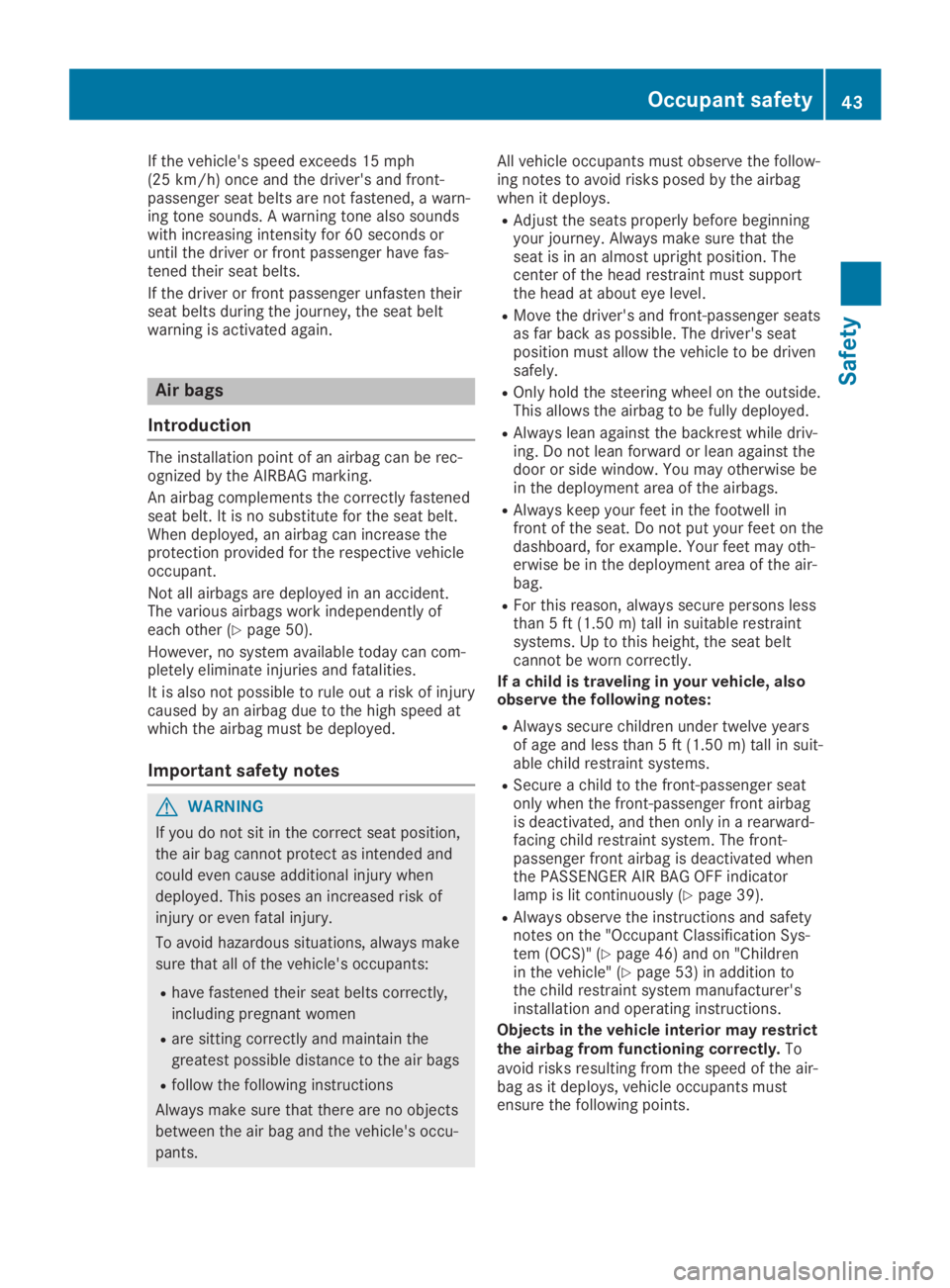
If the vehicle's speed exceeds 15 mph(25 km/h) once and the driver's and front-passenger seat belts are not fastened, a warn-ing tone sounds. A warning tone also soundswith increasing intensity for 60 seconds oruntil the driver or front passenger have fas-tened their seat belts.
If the driver or front passenger unfasten theirseat belts during the journey, the seat beltwarning is activated again.
Air bags
Introduction
The installation point of an airbag can be rec-ognized by the AIRBAG marking.
An airbag complements the correctly fastenedseat belt. It is no substitute for the seat belt.When deployed, an airbag can increase theprotection provided for the respective vehicleoccupant.
Not all airbags are deployed in an accident.The various airbags work independently ofeach other (Ypage 50).
However, no system available today can com-pletely eliminate injuries and fatalities.
It is also not possible to rule out a risk of injurycaused by an airbag due to the high speed atwhich the airbag must be deployed.
Important safety notes
GWARNING
If you do not sit in the correct seat position,
the air bag cannot protect as intended and
could even cause additional injury when
deployed. This poses an increased risk of
injury or even fatal injury.
To avoid hazardous situations, always make
sure that all of the vehicle's occupants:
Rhave fastened their seat belts correctly,
including pregnant women
Rare sitting correctly and maintain the
greatest possible distance to the air bags
Rfollow the following instructions
Always make sure that there are no objects
between the air bag and the vehicle's occu-
pants.
All vehicle occupants must observe the follow-ing notes to avoid risks posed by the airbagwhen it deploys.
RAdjust the seats properly before beginningyour journey. Always make sure that theseat is in an almost upright position. Thecenter of the head restraint must supportthe head at about eye level.
RMove the driver's and front-passenger seatsas far back as possible. The driver's seatposition must allow the vehicle to be drivensafely.
ROnly hold the steering wheel on the outside.This allows the airbag to be fully deployed.
RAlways lean against the backrest while driv-ing. Do not lean forward or lean against thedoor or side window. You may otherwise bein the deployment area of the airbags.
RAlways keep your feet in the footwell infront of the seat. Do not put your feet on thedashboard, for example. Your feet may oth-erwise be in the deployment area of the air-bag.
RFor this reason, always secure persons lessthan 5 ft (1.50 m) tall in suitable restraintsystems. Up to this height, the seat beltcannot be worn correctly.
If a child is traveling in your vehicle, alsoobserve the following notes:
RAlways secure children under twelve yearsof age and less than 5 ft (1.50 m) tall in suit-able child restraint systems.
RSecure a child to the front-passenger seatonly when the front-passenger front airbagis deactivated, and then only in a rearward-facing child restraint system. The front-passenger front airbag is deactivated whenthe PASSENGER AIR BAG OFF indicatorlamp is lit continuously (Ypage 39).
RAlways observe the instructions and safetynotes on the "Occupant Classification Sys-tem (OCS)" (Ypage 46) and on "Childrenin the vehicle" (Ypage 53) in addition tothe child restraint system manufacturer'sinstallation and operating instructions.
Objects in the vehicle interior may restrictthe airbag from functioning correctly.Toavoid risks resulting from the speed of the air-bag as it deploys, vehicle occupants mustensure the following points.
Occupant safety43
Safety
Z
Page 46 of 306
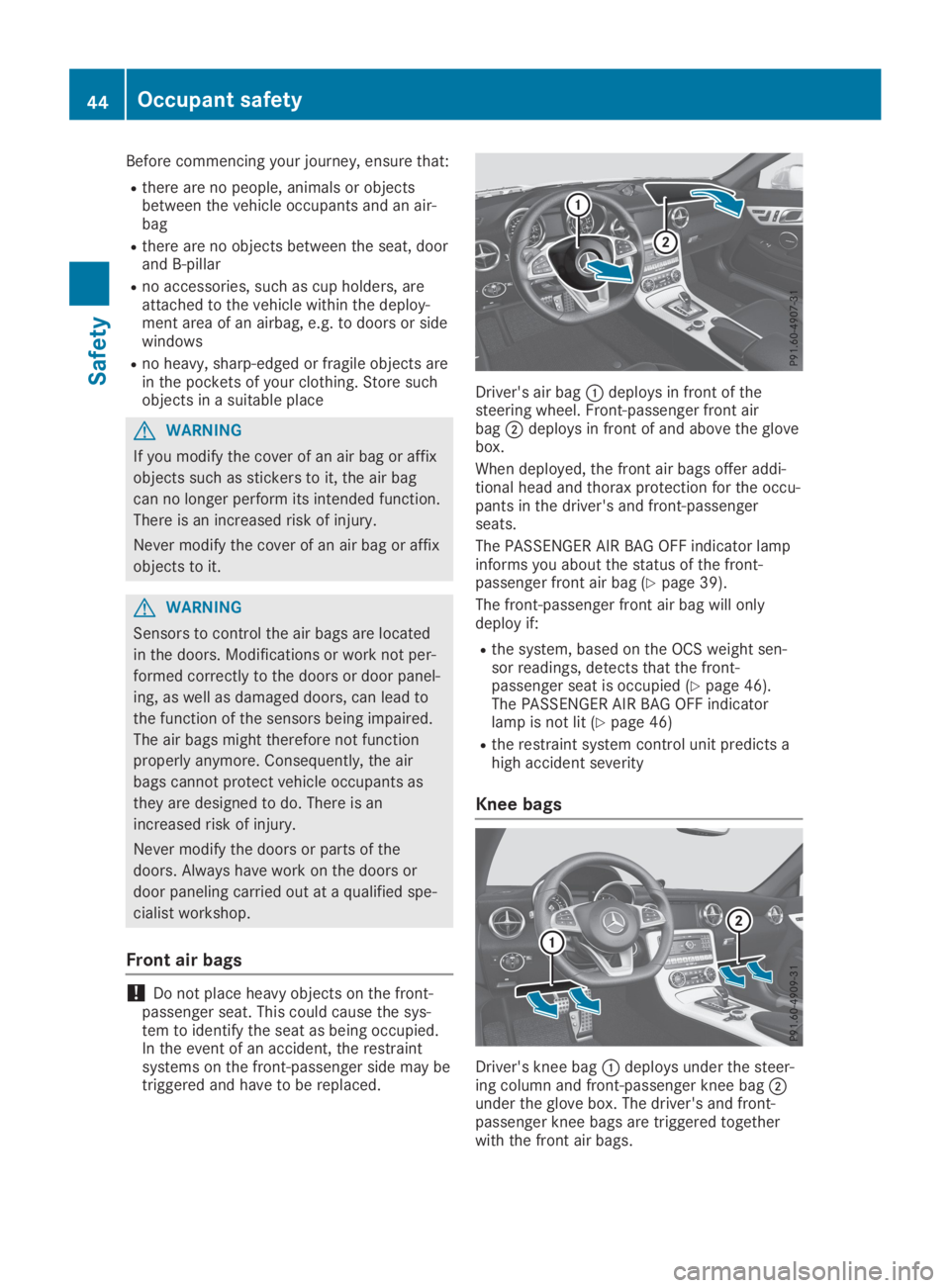
Before commencing your journey, ensure that:
Rthere are no people, animals or objectsbetween the vehicle occupants and an air-bag
Rthere are no objects between the seat, doorand B-pillar
Rno accessories, such as cup holders, areattached to the vehicle within the deploy-ment area of an airbag, e.g. to doors or sidewindows
Rno heavy, sharp-edged or fragile objects arein the pockets of your clothing. Store suchobjects in a suitable place
GWARNING
If you modify the cover of an air bag or affix
objects such as stickers to it, the air bag
can no longer perform its intended function.
There is an increased risk of injury.
Never modify the cover of an air bag or affix
objects to it.
GWARNING
Sensors to control the air bags are located
in the doors. Modifications or work not per-
formed correctly to the doors or door panel-
ing, as well as damaged doors, can lead to
the function of the sensors being impaired.
The air bags might therefore not function
properly anymore. Consequently, the air
bags cannot protect vehicle occupants as
they are designed to do. There is an
increased risk of injury.
Never modify the doors or parts of the
doors. Always have work on the doors or
door paneling carried out at a qualified spe-
cialist workshop.
Front air bags
!Do not place heavy objects on the front-passenger seat. This could cause the sys-tem to identify the seat as being occupied.In the event of an accident, the restraintsystems on the front-passenger side may betriggered and have to be replaced.
Driver's air bag�Cdeploys in front of thesteering wheel. Front-passenger front airbag�Ddeploys in front of and above the glovebox.
When deployed, the front air bags offer addi-tional head and thorax protection for the occu-pants in the driver's and front-passengerseats.
The PASSENGER AIR BAG OFF indicator lampinforms you about the status of the front-passenger front air bag (Ypage 39).
The front-passenger front air bag will onlydeploy if:
Rthe system, based on the OCS weight sen-sor readings, detects that the front-passenger seat is occupied (Ypage 46).The PASSENGER AIR BAG OFF indicatorlamp is not lit (Ypage 46)
Rthe restraint system control unit predicts ahigh accident severity
Knee bags
Driver's knee bag�Cdeploys under the steer-ing column and front-passenger knee bag�Dunder the glove box. The driver's and front-passenger knee bags are triggered togetherwith the front air bags.
44Occupant safety
Safety
Page 47 of 306
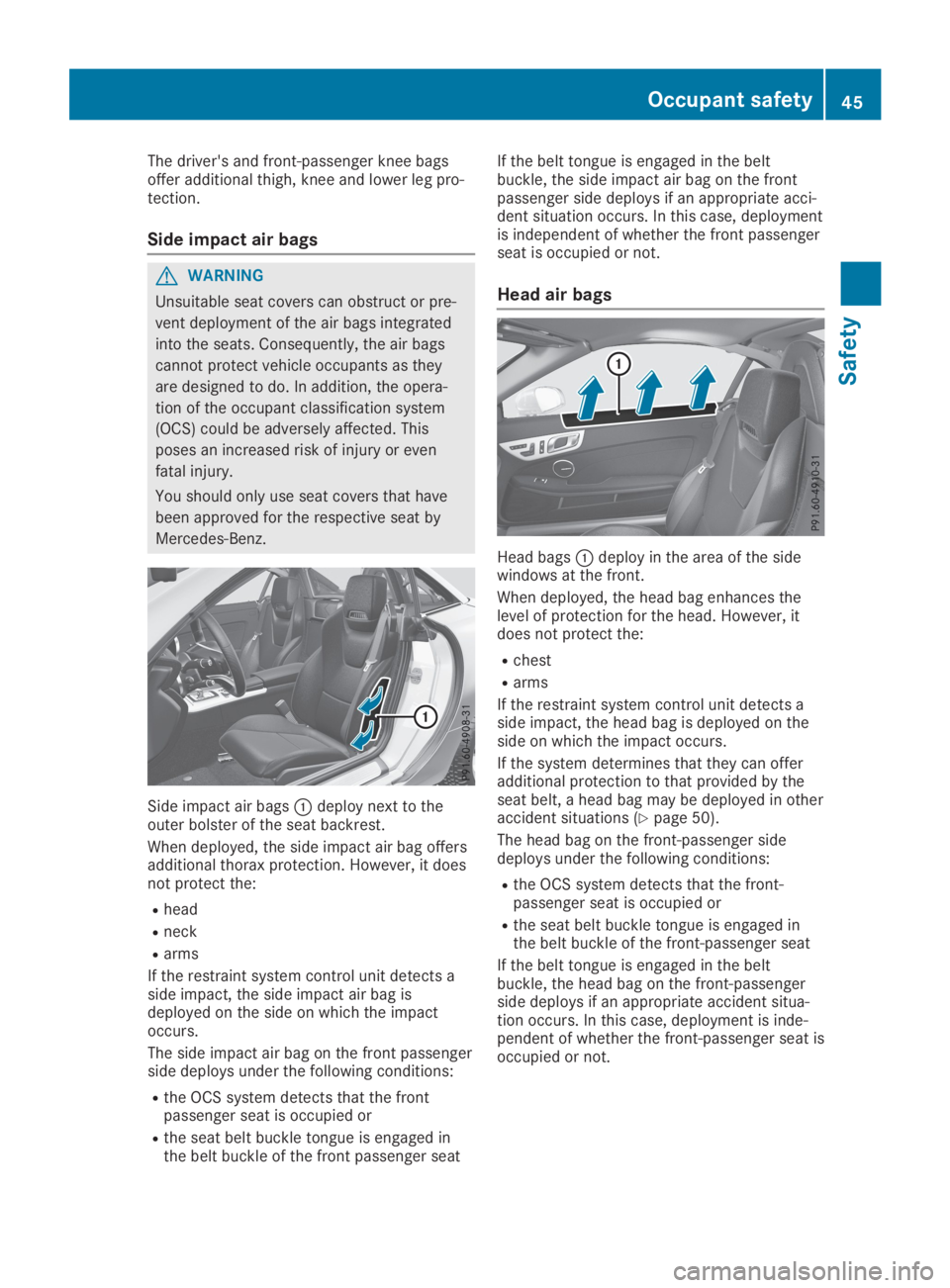
The driver's and front-passenger knee bagsoffer additional thigh, knee and lower leg pro-tection.
Side impact air bags
GWARNING
Unsuitable seat covers can obstruct or pre-
vent deployment of the air bags integrated
into the seats. Consequently, the air bags
cannot protect vehicle occupants as they
are designed to do. In addition, the opera-
tion of the occupant classification system
(OCS) could be adversely affected. This
poses an increased risk of injury or even
fatal injury.
You should only use seat covers that have
been approved for the respective seat by
Mercedes-Benz.
Side impact air bags�Cdeploy next to theouter bolster of the seat backrest.
When deployed, the side impact air bag offersadditional thorax protection. However, it doesnot protect the:
Rhead
Rneck
Rarms
If the restraint system control unit detects aside impact, the side impact air bag isdeployed on the side on which the impactoccurs.
The side impact air bag on the front passengerside deploys under the following conditions:
Rthe OCS system detects that the frontpassenger seat is occupied or
Rthe seat belt buckle tongue is engaged inthe belt buckle of the front passenger seat
If the belt tongue is engaged in the beltbuckle, the side impact air bag on the frontpassenger side deploys if an appropriate acci-dent situation occurs. In this case, deploymentis independent of whether the front passengerseat is occupied or not.
Head air bags
Head bags�Cdeploy in the area of the sidewindows at the front.
When deployed, the head bag enhances thelevel of protection for the head. However, itdoes not protect the:
Rchest
Rarms
If the restraint system control unit detects aside impact, the head bag is deployed on theside on which the impact occurs.
If the system determines that they can offeradditional protection to that provided by theseat belt, a head bag may be deployed in otheraccident situations (Ypage 50).
The head bag on the front-passenger sidedeploys under the following conditions:
Rthe OCS system detects that the front-passenger seat is occupied or
Rthe seat belt buckle tongue is engaged inthe belt buckle of the front-passenger seat
If the belt tongue is engaged in the beltbuckle, the head bag on the front-passengerside deploys if an appropriate accident situa-tion occurs. In this case, deployment is inde-pendent of whether the front-passenger seat isoccupied or not.
Occupant safety45
Safety
Z
Page 54 of 306
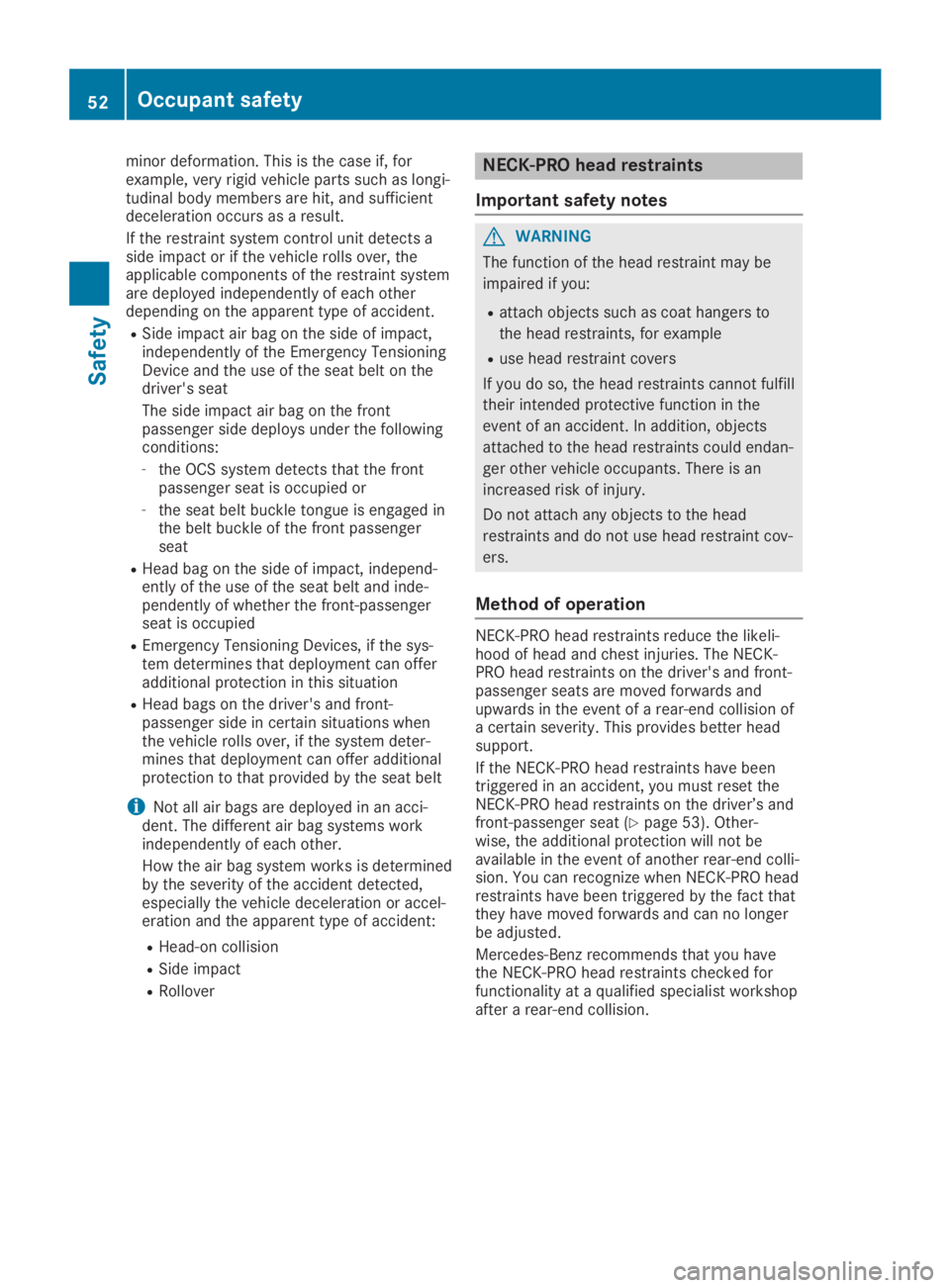
minor deformation. This is the case if, forexample, very rigid vehicle parts such as longi-tudinal body members are hit, and sufficientdeceleration occurs as a result.
If the restraint system control unit detects aside impact or if the vehicle rolls over, theapplicable components of the restraint systemare deployed independently of each otherdepending on the apparent type of accident.
RSide impact air bag on the side of impact,independently of the Emergency TensioningDevice and the use of the seat belt on thedriver's seat
The side impact air bag on the frontpassenger side deploys under the followingconditions:
-the OCS system detects that the frontpassenger seat is occupied or
-the seat belt buckle tongue is engaged inthe belt buckle of the front passengerseat
RHead bag on the side of impact, independ-ently of the use of the seat belt and inde-pendently of whether the front-passengerseat is occupied
REmergency Tensioning Devices, if the sys-tem determines that deployment can offeradditional protection in this situation
RHead bags on the driver's and front-passenger side in certain situations whenthe vehicle rolls over, if the system deter-mines that deployment can offer additionalprotection to that provided by the seat belt
iNot all air bags are deployed in an acci-dent. The different air bag systems workindependently of each other.
How the air bag system works is determinedby the severity of the accident detected,especially the vehicle deceleration or accel-eration and the apparent type of accident:
RHead-on collision
RSide impact
RRollover
NECK-PRO head restraints
Important safety notes
GWARNING
The function of the head restraint may be
impaired if you:
Rattach objects such as coat hangers to
the head restraints, for example
Ruse head restraint covers
If you do so, the head restraints cannot fulfill
their intended protective function in the
event of an accident. In addition, objects
attached to the head restraints could endan-
ger other vehicle occupants. There is an
increased risk of injury.
Do not attach any objects to the head
restraints and do not use head restraint cov-
ers.
Method of operation
NECK-PRO head restraints reduce the likeli-hood of head and chest injuries. The NECK-PRO head restraints on the driver's and front-passenger seats are moved forwards andupwards in the event of a rear-end collision ofa certain severity. This provides better headsupport.
If the NECK-PRO head restraints have beentriggered in an accident, you must reset theNECK-PRO head restraints on the driver’s andfront-passenger seat (Ypage 53). Other-wise, the additional protection will not beavailable in the event of another rear-end colli-sion. You can recognize when NECK-PRO headrestraints have been triggered by the fact thatthey have moved forwards and can no longerbe adjusted.
Mercedes-Benz recommends that you havethe NECK-PRO head restraints checked forfunctionality at a qualified specialist workshopafter a rear-end collision.
52Occupant safety
Safety
Page 88 of 306
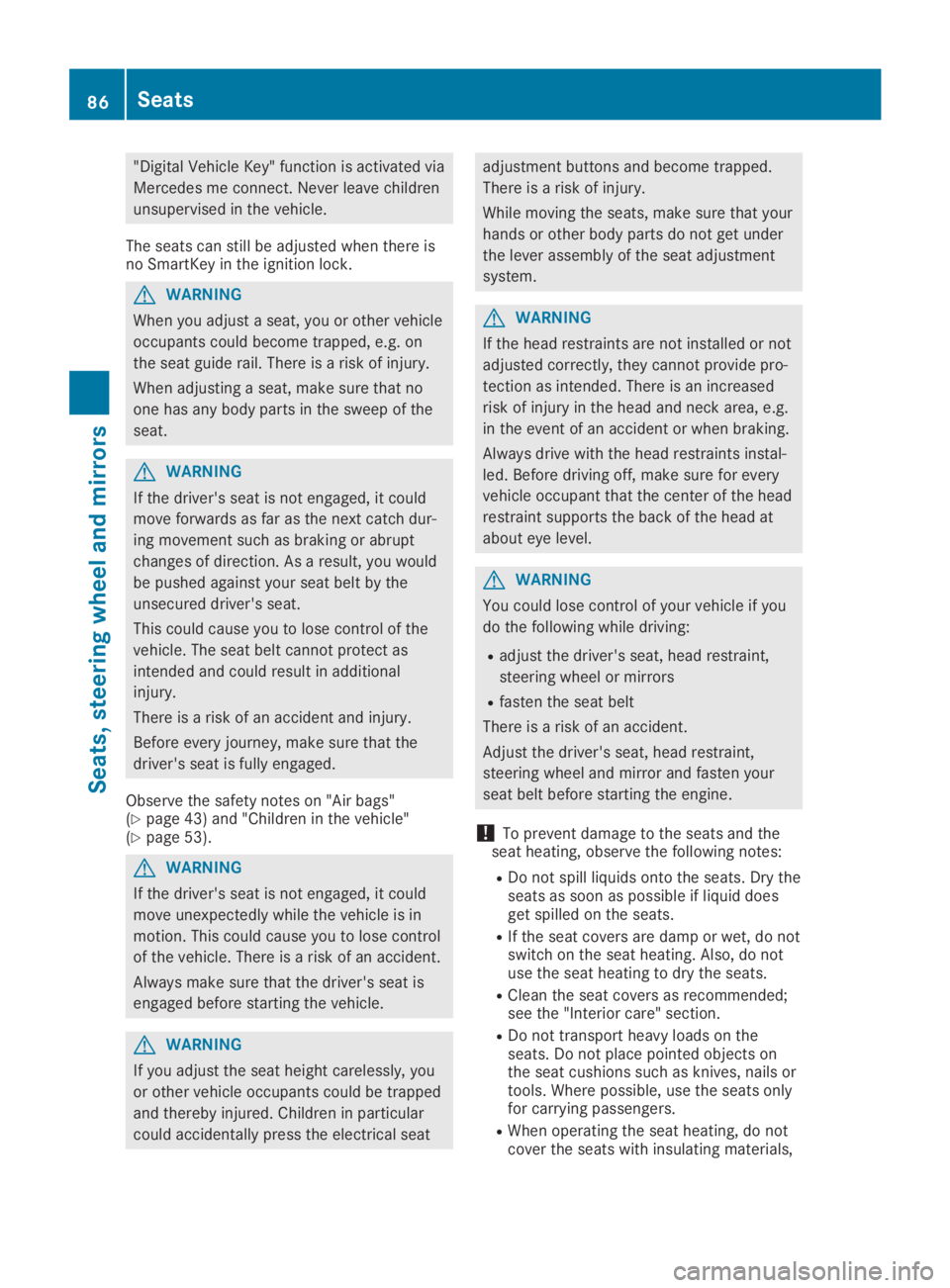
"Digital Vehicle Key" function is activated via
Mercedes me connect. Never leave children
unsupervised in the vehicle.
The seats can still be adjusted when there isno SmartKey in the ignition lock.
GWARNING
When you adjust a seat, you or other vehicle
occupants could become trapped, e.g. on
the seat guide rail. There is a risk of injury.
When adjusting a seat, make sure that no
one has any body parts in the sweep of the
seat.
GWARNING
If the driver's seat is not engaged, it could
move forwards as far as the next catch dur-
ing movement such as braking or abrupt
changes of direction. As a result, you would
be pushed against your seat belt by the
unsecured driver's seat.
This could cause you to lose control of the
vehicle. The seat belt cannot protect as
intended and could result in additional
injury.
There is a risk of an accident and injury.
Before every journey, make sure that the
driver's seat is fully engaged.
Observe the safety notes on "Air bags"(Ypage 43) and "Children in the vehicle"(Ypage 53).
GWARNING
If the driver's seat is not engaged, it could
move unexpectedly while the vehicle is in
motion. This could cause you to lose control
of the vehicle. There is a risk of an accident.
Always make sure that the driver's seat is
engaged before starting the vehicle.
GWARNING
If you adjust the seat height carelessly, you
or other vehicle occupants could be trapped
and thereby injured. Children in particular
could accidentally press the electrical seat
adjustment buttons and become trapped.
There is a risk of injury.
While moving the seats, make sure that your
hands or other body parts do not get under
the lever assembly of the seat adjustment
system.
GWARNING
If the head restraints are not installed or not
adjusted correctly, they cannot provide pro-
tection as intended. There is an increased
risk of injury in the head and neck area, e.g.
in the event of an accident or when braking.
Always drive with the head restraints instal-
led. Before driving off, make sure for every
vehicle occupant that the center of the head
restraint supports the back of the head at
about eye level.
GWARNING
You could lose control of your vehicle if you
do the following while driving:
Radjust the driver's seat, head restraint,
steering wheel or mirrors
Rfasten the seat belt
There is a risk of an accident.
Adjust the driver's seat, head restraint,
steering wheel and mirror and fasten your
seat belt before starting the engine.
!To prevent damage to the seats and theseat heating, observe the following notes:
RDo not spill liquids onto the seats. Dry theseats as soon as possible if liquid doesget spilled on the seats.
RIf the seat covers are damp or wet, do notswitch on the seat heating. Also, do notuse the seat heating to dry the seats.
RClean the seat covers as recommended;see the "Interior care" section.
RDo not transport heavy loads on theseats. Do not place pointed objects onthe seat cushions such as knives, nails ortools. Where possible, use the seats onlyfor carrying passengers.
RWhen operating the seat heating, do notcover the seats with insulating materials,
86Seats
Seats, steering wheel and mirrors
Page 89 of 306
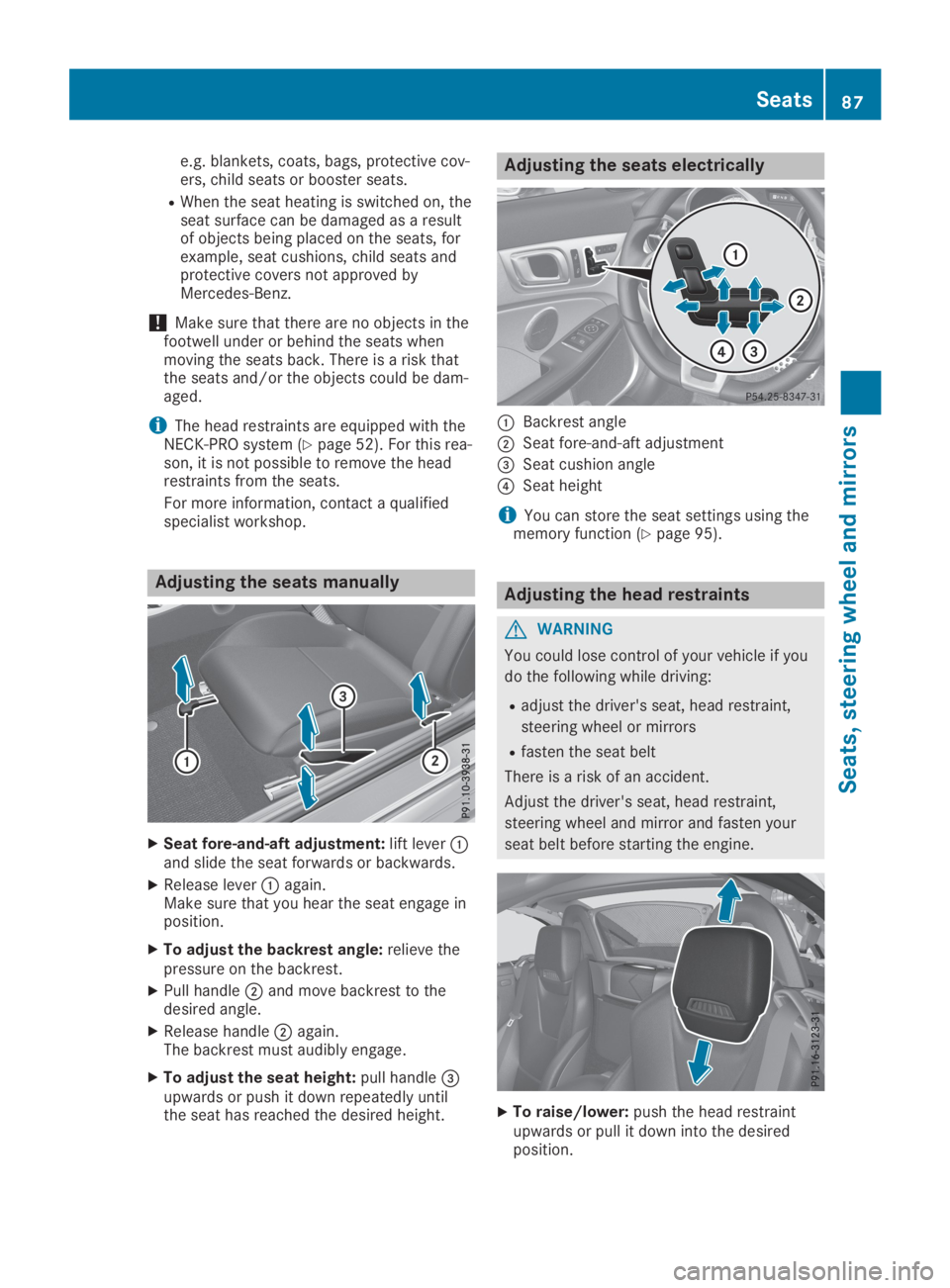
e.g. blankets, coats, bags, protective cov-ers, child seats or booster seats.
RWhen the seat heating is switched on, theseat surface can be damaged as a resultof objects being placed on the seats, forexample, seat cushions, child seats andprotective covers not approved byMercedes-Benz.
!Make sure that there are no objects in thefootwell under or behind the seats whenmoving the seats back. There is a risk thatthe seats and/or the objects could be dam-aged.
iThe head restraints are equipped with theNECK-PRO system (Ypage 52). For this rea-son, it is not possible to remove the headrestraints from the seats.
For more information, contact a qualifiedspecialist workshop.
Adjusting the seats manually
XSeat fore-and-aft adjustment:lift lever�Cand slide the seat forwards or backwards.
XRelease lever�Cagain.Make sure that you hear the seat engage inposition.
XTo adjust the backrest angle:relieve thepressure on the backrest.
XPull handle�Dand move backrest to thedesired angle.
XRelease handle�Dagain.The backrest must audibly engage.
XTo adjust the seat height:pull handle�
Page 91 of 306
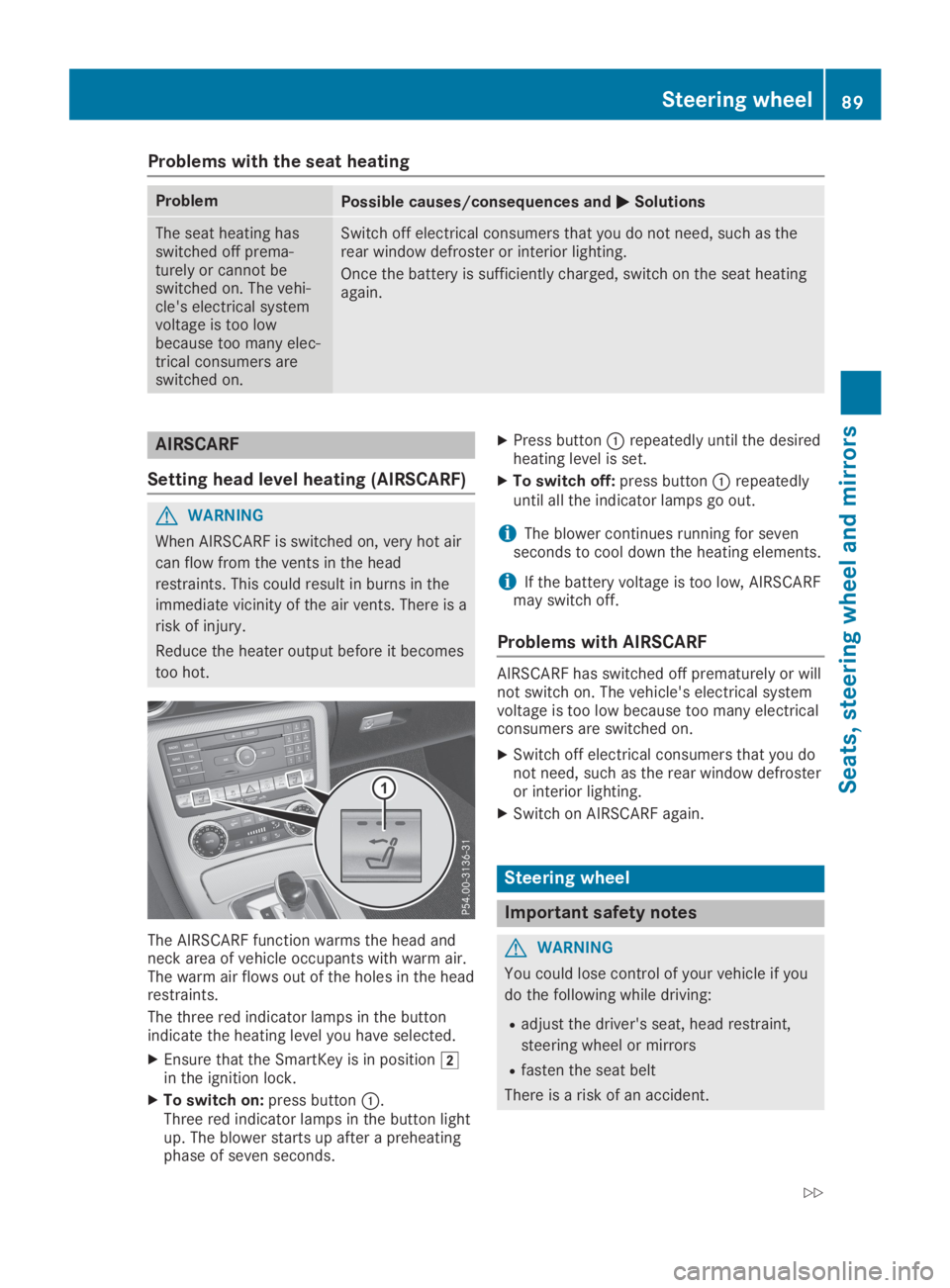
Problems with the seat heating
ProblemPossible causes/consequences and�P�PSolutions
The seat heating hasswitched off prema-turely or cannot beswitched on. The vehi-cle's electrical systemvoltage is too lowbecause too many elec-trical consumers areswitched on.
Switch off electrical consumers that you do not need, such as therear window defroster or interior lighting.
Once the battery is sufficiently charged, switch on the seat heatingagain.
AIRSCARF
Setting head level heating (AIRSCARF)
GWARNING
When AIRSCARF is switched on, very hot air
can flow from the vents in the head
restraints. This could result in burns in the
immediate vicinity of the air vents. There is a
risk of injury.
Reduce the heater output before it becomes
too hot.
The AIRSCARF function warms the head andneck area of vehicle occupants with warm air.The warm air flows out of the holes in the headrestraints.
The three red indicator lamps in the buttonindicate the heating level you have selected.
XEnsure that the SmartKey is in position�Hin the ignition lock.
XTo switch on:press button�C.Three red indicator lamps in the button lightup. The blower starts up after a preheatingphase of seven seconds.
XPress button�Crepeatedly until the desiredheating level is set.
XTo switch off:press button�Crepeatedlyuntil all the indicator lamps go out.
iThe blower continues running for sevenseconds to cool down the heating elements.
iIf the battery voltage is too low, AIRSCARFmay switch off.
Problems with AIRSCARF
AIRSCARF has switched off prematurely or willnot switch on. The vehicle's electrical systemvoltage is too low because too many electricalconsumers are switched on.
XSwitch off electrical consumers that you donot need, such as the rear window defrosteror interior lighting.
XSwitch on AIRSCARF again.
Steering wheel
Important safety notes
GWARNING
You could lose control of your vehicle if you
do the following while driving:
Radjust the driver's seat, head restraint,
steering wheel or mirrors
Rfasten the seat belt
There is a risk of an accident.
Steering wheel89
Seats, steering wheel and mirrors
Z
Page 94 of 306
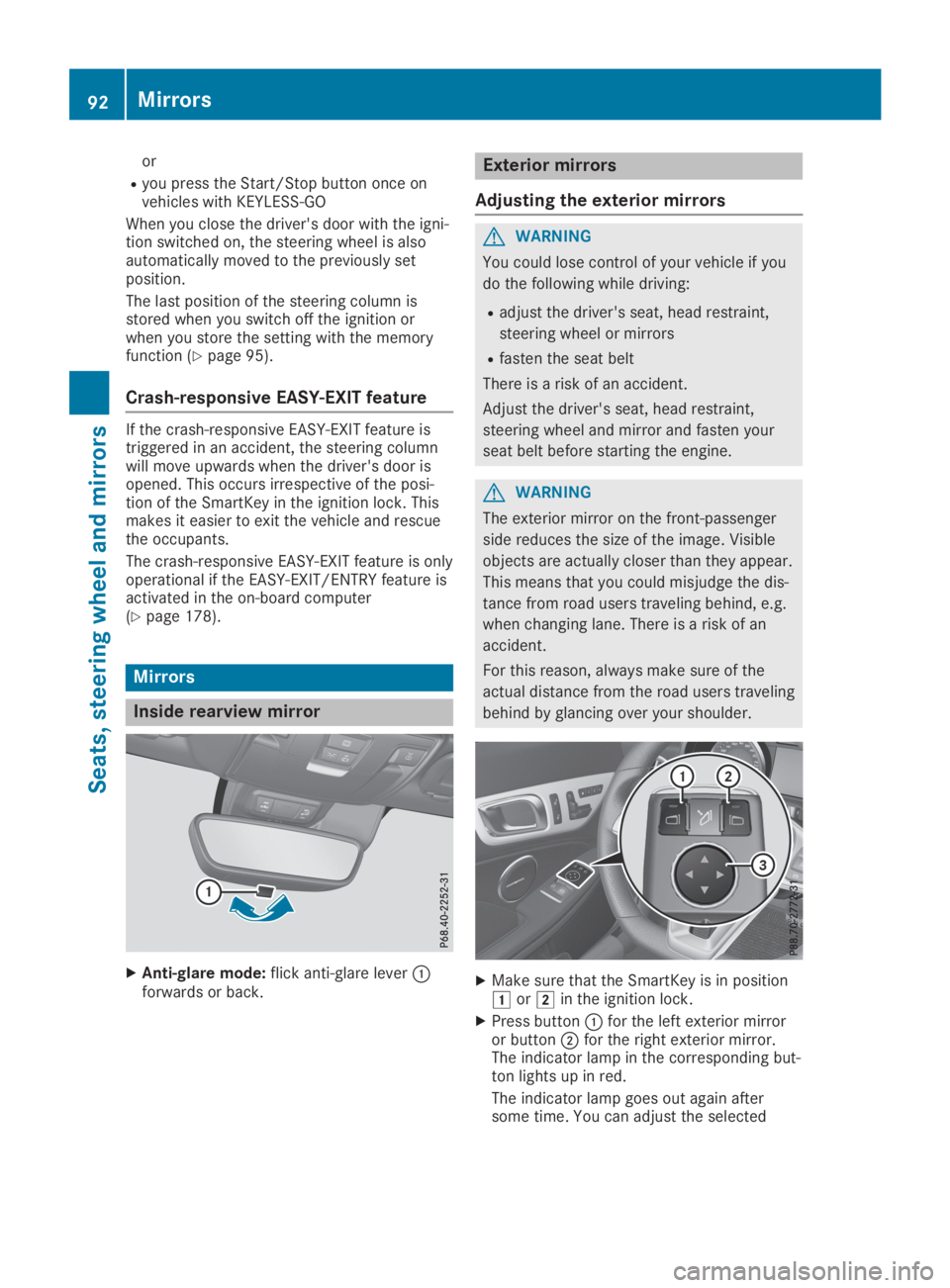
or
Ryou press the Start/Stop button once onvehicles with KEYLESS-GO
When you close the driver's door with the igni-tion switched on, the steering wheel is alsoautomatically moved to the previously setposition.
The last position of the steering column isstored when you switch off the ignition orwhen you store the setting with the memoryfunction (Ypage 95).
Crash-responsive EASY-EXIT feature
If the crash-responsive EASY-EXIT feature istriggered in an accident, the steering columnwill move upwards when the driver's door isopened. This occurs irrespective of the posi-tion of the SmartKey in the ignition lock. Thismakes it easier to exit the vehicle and rescuethe occupants.
The crash-responsive EASY-EXIT feature is onlyoperational if the EASY-EXIT/ENTRY feature isactivated in the on-board computer(Ypage 178).
Mirrors
Inside rearview mirror
XAnti-glare mode:flick anti-glare lever�Cforwards or back.
Exterior mirrors
Adjusting the exterior mirrors
GWARNING
You could lose control of your vehicle if you
do the following while driving:
Radjust the driver's seat, head restraint,
steering wheel or mirrors
Rfasten the seat belt
There is a risk of an accident.
Adjust the driver's seat, head restraint,
steering wheel and mirror and fasten your
seat belt before starting the engine.
GWARNING
The exterior mirror on the front-passenger
side reduces the size of the image. Visible
objects are actually closer than they appear.
This means that you could misjudge the dis-
tance from road users traveling behind, e.g.
when changing lane. There is a risk of an
accident.
For this reason, always make sure of the
actual distance from the road users traveling
behind by glancing over your shoulder.
XMake sure that the SmartKey is in position�Gor�Hin the ignition lock.
XPress button�Cfor the left exterior mirroror button�Dfor the right exterior mirror.The indicator lamp in the corresponding but-ton lights up in red.
The indicator lamp goes out again aftersome time. You can adjust the selected
92Mirrors
Seats, steering wheel and mirrors